Best Management Practices
Most pesticide applications by tree care professionals are due to a few exotic pests.

Editor's note: In August 2019, minor updates were made to the emerald ash borer BMPs under the Ash Trees section.
Most pesticide applications by tree care professionals are due to a few exotic pests. Because our native trees may lack natural resistance to these invasive pests and we do not have the right species of predators and parasitoids to keep them under control, good cultural practices may not be enough to save the trees and shrubs they attack. For the following invasive pest species, consider replacing the host tree with a tree that does not have an invasive pest problem. Or, follow the Best Management Practices (BMPs) listed for each invasive pest. These practices are designed to save the infested tree while minimizing harmful effects of pesticides on pollinators and other beneficial insects. Each section starts with a summary of the importance of the host tree or shrub as a food source for pollinators or beneficial insects. BMPs are most important to implement for trees and shrubs that are important food plants for pollinators.
- Protecting susceptible trees and shrubs from invasive pests
- Protecting imported and native trees from native pests
- BMPs for spring defoliators
- BMPs for apple scab on crabapples
- Accurate knowledge of bloom period for
selecting trees and shrubs and timing pest management strategies - Phenological sequence table
- Protecting pollinators during home lawn grub control
Protecting susceptible trees and shrubs from invasive pests
Ash trees (Fraxinus spp.)
Importance to pollinators: Ash trees can be an important source of pollen for bees during a two-week period in early spring when they bloom. Ash trees do not produce nectar.
Invasive pest: Emerald ash borer.
BMPs: Emerald ash borer is steadily spreading in the Eastern U.S. and into some western states. It is killing all ash trees in natural and managed landscapes. Insecticides can be used to preserve individual trees, but all are potentially toxic to pollinators if the insecticide moves into ash pollen.
Ash is wind-pollinated and does not produce nectar, but honey bees may collect ash pollen, and some native bees will fill larval chambers with up to 25% ash pollen during late April and early May when ash flowers. In Ohio and Michigan, white and green ash begin flowering at 190 degree-days, peaking at 240 degree-days, coinciding with flowering of many crabapples. Flowering times based on degree-days should be similar in most of the north central U.S.
No information is currently available on the amount of imidacloprid, dinotefuran or emamectin benzoate that moves into ash pollen following treatments for emerald ash borer. Based on research with other types of trees, it is likely trunk injections, trunk sprays or basal soil drenches of systemic insecticides applied before bloom will result in some insecticide in the pollen. To minimize the impact on pollinators, wait until after ash trees are done blooming, typically mid-May in our region, to make treatments. We will update the information here when research findings on insecticide residue in ash pollen is available.
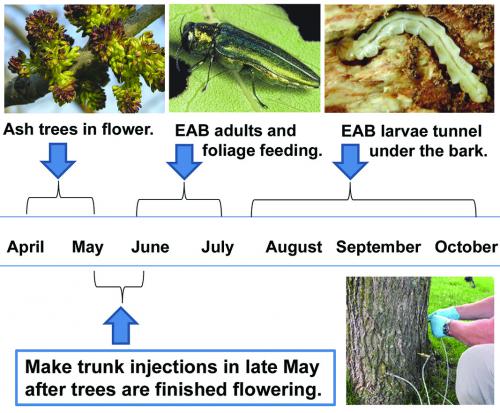
Hemlocks (Tsuga sp.)
Importance to pollinators: Hemlock trees produce large amounts of pollen in the spring, but this pollen is not a nutritious food source for bees. However, because hemlock pollen may dust all the surrounding plants for several weeks, bees may be exposed to trace amounts that mix with the pollen of more preferred plants. Hemlocks do not produce nectar.
Invasive pest: Hemlock woolly adelgid.
BMPs: Because hemlock pollen is not usually collected by bees, it is unlikely that standard insecticide treatments of hemlock trees to protect against hemlock woolly adelgids will impact pollinators. However, because abundant amounts of pollen may be produced, contamination of other types of pollen can be minimized by treating hemlock trees with systemic neonicotinoid insecticides in late spring after trees have finished flowering. Also, recent research indicates that imidacloprid is much less likely than dinotefuran to appear in pollen and nectar the year after treatments are made. Another concern is neighboring flowering plants may pick up systemic insecticides from soil treatments of hemlocks, if the plants’ root systems overlap.
A treatment method that mitigates this risk is to apply systemic insecticides through trunk injection or as a basal bark spray. A single application of a systemic insecticide typically provides at least two and up to seven years of protection of hemlocks from injury by hemlock woolly adelgids, and consequently, is a very efficient treatment option.
Frequent sprays with insecticidal soap or horticultural oil have been suggested as alternative products for controlling hemlock woolly adelgids because they are less harmful to pollinators. However, these products tend to be less effective as the soap or oil must contact the insect and are impractical for treating large trees.
Evergreen Euonymus (Euonymus spp.), Pachysandra (Pachysandra spp.) and bittersweet (Celastrus spp.)
Importance to pollinators: Euonymus, pachysandra and bittersweet pollen can be collected by bees, but they are not considered an important source of pollen.
Invasive pest: Euonymus scale.
BMPs: Susceptible types of Euonymus sp. are almost guaranteed to become infested with euonymus scale, decline slowly and become thin and unsightly. The most effective insecticide treatments for euonymus scale are an IGR (Pyriproxyfen) or horticultural oil applied as a foliar spray during crawler emergence in late spring. Pyriproxyfen is not harmful to adult bees or butterflies, but it is not known if it affects bee larvae fed with tainted pollen. A 2% concentration of horticultural oil applied during crawler emergence is the safest treatment for pollinators. Avoid spraying when bees are present.
Roses (Rosa spp.), Lindens (Tilia spp.), raspberries (Rubus spp.), blueberries (Vaccinium spp.), birch (Betula spp.) and many others
Importance to pollinators: Hybrid tea roses, rugosa roses and the popular Knock out roses are weak nectar and pollen producers. In a survey in Colorado, most Rosa spp. in gardens were observed to be “rarely visited by bees,” but a few rose plants were “frequently visited by bees.” Linden trees, birch trees, raspberries and blueberries are highly attractive to bees.
Invasive pest: Japanese beetle.
BMPs: Rugosa rose foliage is not skeletonized by Japanese beetles, but the beetles may feed on flowers. Flower feeding on rugosa roses is not nearly as much of a problem as it is on hybrid tea roses.
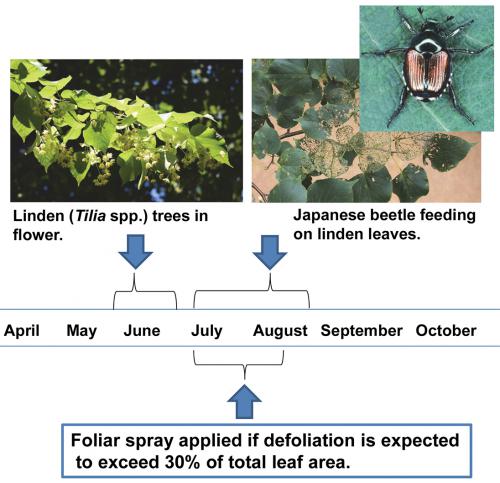
Standard insecticide sprays used to protect hybrid tea roses (carbaryl, bifenthrin, cyfluthrin and other pyrethroids) are highly toxic to pollinators and other beneficial insects. Chlorantraniliprole is an alternative insecticide that provides good control of Japanese beetles as a foliar spray, but is much less toxic to bees. Chlorantraniliprole is the preferred product to use for Japanese beetles to protect bees, even if some drift is expected to other flowers. If carbaryl, bifenthrin, cyfluthrin or another pyrethroid insecticide is used, do not spray for Japanese beetles until after all flowers have dropped (usually after July 1 in Michigan), and avoid any drift to other flowers or food plants for caterpillars
Viburnum (Viburnum sp.)
Importance to pollinators: Viburnum flowers are often mentioned as being attractive to bees. Some types of viburnum may be more attractive than others. Two species described as very attractive to bees are Viburnum plicatum and Viburnum davidii.
Invasive pest: Viburnum leaf beetle.
BMPs: Viburnum leaf beetle adults and larvae are active from late spring to early summer. Because of a lack of natural enemies, extensive feeding injury can defoliate viburnum shrubs. Avoid spraying when viburnum plants are flowering, or use chlorantraniliprole during bloom to minimize impact on pollinators. An insecticide applied after the flowering period is over will not be harmful to bees unless there is some drift to nearby flowering weeds or perennial flowers.
Oaks (Quercus sp.), birch (Betula sp.) and poplar (Populus sp.)
Importance to pollinators: Bees are often observed collecting pollen from oak and birch catkins in May in Michigan. Oak, birch and poplar flowers are wind-pollinated and do not produce nectar.
Invasive pest: Gypsy moth.
BMPs: The most widely used insecticide for protecting oak, birch and poplar trees from defoliation by gypsy moth caterpillars is B.t., which is not harmful to bees or butterfly adults. However, B.t. is toxic to all butterfly larvae (caterpillars). B.t. does not persist more than seven to 10 days after it is sprayed and should not be harmful to caterpillars that hatch more than two weeks after it is sprayed. The IGR dimilin is also used to protect trees from gypsy moth caterpillars. It is not harmful to adult bees or adult butterflies, but a negative impact on bee larvae fed tainted pollen is suspected. Dimilin is toxic to all caterpillars and persists for at least two months after application.
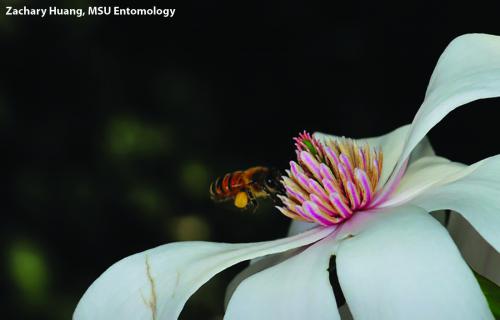
Magnolia (Magnolia sp.)
Importance to pollinators: Some types of flowering magnolia are highly attractive to bees for their pollen and nectar, but bee activity on early blooming (April) species depends on the daily temperature, with little activity when the temperature is below 55 degrees Fahrenheit. Species and cultivars vary in attractiveness, but the most fragrant cultivars tend to be the most attractive.
Invasive pest: Magnolia scale.
BMPs: Magnolia scale does not affect tree health unless the sugary waste excretion (honeydew) drips onto leaves under the scale insects causing a black fungus (sooty mold) to grow that may completely cover leaves. Most infestations can be ignored. If trees become unsightly, a 2% solution of horticultural oil can be sprayed after magnolias are done flowering in spring to suppress magnolia scale, but this approach is not always successful.
One practice that is being used by some arborists is applying a dilute solution of imidacloprid or dinotefuran around the base of infested trees (a basal soil drench). Both of these insecticides are highly toxic to bees and should not be applied until trees are done blooming. This will minimize any potential impact on pollinators the following year. Dinotefuran degrades more rapidly and is less likely to be present at harmful concentrations in pollen and nectar the following spring. Acetamiprid may be used as a basal spray for systemic control of insects and is much less toxic to bees than either dinotefuran or imidacloprid.
Protecting imported and native trees from native pests
European white birch (Betula pendula)
Importance to pollinators: Although birch is a wind-pollinated tree, the spring catkins produce a lot of pollen that may be collected by bees.
Native pest: Bronze birch borer.
BMPs: The best option is to grow species of birch native to North America because they are resistant to bronze birch borer. However, many garden centers still carry European white birch, Betula pendula, which is very susceptible to bronze birch borer. In fact, European white birch trees will very likely die within 20 years of when they are planted due to borer injury. The standard practice to preserve European white birch trees is to use a trunk injection of emamectin benzoate every third year, or a trunk injection or soil drench of imidacloprid each year. Trunk injections should be made in late May after birch trees are done flowering. We do not know at this time how much, if any, insecticide will be in the pollen the following year.
Basal soil drenches of imidacloprid applied after flowering, will also protect birch trees while minimizing the impact on pollinators the following year. Dinotefuran is not recommended because it may appear in pollen the following year.
Austrian pine (Pinus nigra) and Scots pine (Pinus sylvestris)
Importance to pollinators: The pollen of Austrian pine, Scots pine, all pine and spruce trees is not used by bees, and therefore is not important to pollinators.
Native pest: Zimmerman pine moth.
BMPs: There is little risk to pollinators because bees do not use pine pollen. However, the standard practice of spraying trunks and large branches in April or May could result in insecticide spray drift to nearby flowers. Most of the bark-applied insecticides persist a long time, so it would be best to spray in late March or early April before most trees and shrubs bloom, and before most bees become active. Honey bees will sometimes use pine tree sap to make propolis, which acts like a glue to hold the hive together. Check to make sure bees are not on the trunks or branches before spraying.
Arborvitae (Thuja sp.)
Importance to pollinators: Arborvitae pollen is not used by bees.
Native pest: Bagworm.
BMPs: If a spray is used, avoid drift to surrounding plants. If surrounding trees or shrubs are attractive to bees, and the roots grow into the arborvitae root zone, apply basal soil drenches after the surrounding trees have bloomed.
Cherry trees (Prunus sp.)
Importance to pollinators: The flowers of nearly all Prunus species are highly attractive to bees.
Native pest: Eastern tent caterpillar.
BMPs: Eastern tent caterpillars can be removed by scraping the caterpillar-filled tent off the tree and putting it into soapy water. Eastern tent caterpillars can also be controlled by spraying the tree canopy with B.t. or chlorantraniliprole, which are not harmful to bees. If any other insecticide is used, spray after the cherry trees have bloomed and avoid drift onto nearby flowers.

BMPs for spring defoliators
A number of different types of caterpillars feed on trees in spring and may be referred to as spring defoliators. Fall and spring cankerworm, gypsy moth, forest tent caterpillar and eastern tent caterpillar are some of the more common ones. With the exception of gypsy moth in outbreak areas, spring defoliators rarely cause enough feeding damage to justify using an insecticide. Shade trees can lose over one-third of their foliage from caterpillar feeding without any harmful effects on tree health.
If trees are losing more than a third of their entire canopy, a B.t or chlorantraniliprole spray will stop caterpillar feeding without harming pollinators. These are the only two products that can be used when trees are flowering without harming bees. Spinosad or diflubenzuron sprayed after the tree is done blooming will also minimize any impact on beneficial insects in the area.
BMPs for apple scab on crabapples
Protecting susceptible crabapple trees from apple scab without harming pollinators will require carefully timed sprays. Gradually replacing susceptible crabapples with resistant ones or another type of tree is the best long-term strategy. The problem is that several commonly used fungicides can be toxic to bee larvae when they are fed tainted pollen. Avoid using captan, ziram, iprodione, chlorothalonil and mancozeb when they are in bloom, and during the last week before the flowers open. Other fungicides may not be as harmful to pollinators, but can still inhibit beneficial fungi that ferment bee bread in honey bee hives.
Unfortunately, fungicide sprays to prevent apple scab are usually recommended to be applied between green tip (just before the leaves open) and petal fall, which includes the time when flowers are open. The best schedule to protect trees while minimizing impacts on pollinators is to spray when leaves begin to open before the first flowers open. Then spray again when the flowers are done blooming and the petals fall off. This is the best schedule for pollinators regardless of which fungicide is used. Still, it is best to avoid using the fungicides listed above that are known to be harmful to bees before the flowers open. After petal fall they are unlikely to affect bees, unless the spray drifts onto the flowers of nearby trees and shrubs, or onto perennials, wildflowers or flowering weeds below the trees.

Accurate knowledge of bloom period for
selecting trees and shrubs and timing pest management strategies
The phenological sequence table on the next page gives accurate bloom periods for some of the best flowering trees and shrubs for pollinators grown in the Midwest. Because weather conditions may vary considerably from year to year, trees and shrubs may bloom several weeks earlier or later than usual in any given year. This makes calendar dates an unreliable way to predict when trees will bloom or insect pests emerge.
Throughout this publication we have noted that an important key to protecting pollinators is to avoid spraying plants with insecticides when plants are blooming, and to wait until after plants have bloomed before applying systemic insecticides. When birds migrate, when wildflowers and trees bloom, and the seasonal appearance of insects are examples of phenological events that have been recorded for centuries. Research has shown the first appearance of an insect pest in spring can be matched with a popular type of tree or shrub that blooms at the same time. A tree or shrub in bloom is easier for most to see compared to the emergence of an insect.
A biological calendar to predict when pests are active, when pollinators will be visiting plants and when to schedule pesticide applications to avoid impact on pollinators can be created by comparing when trees bloom and in what order with the insect activity. This order of phenological events, called the phenological sequence, does not change from year to year even when weather patterns differ greatly. Long-term studies in Ohio and Michigan have confirmed this to be the case. With the accompanying table about phenological sequences, pest management activities can be scheduled to protect pollinators.
For example, emerald ash borer adults begin emerging very predictably when black locust trees are blooming. In northern Ohio, the ideal time to treat ash for emerald ash borer with a systemic insecticide is after ash blooms in late April to early May and before black locust blooms in late May. Japanese beetle adults first emerge as little-leaf linden begins to bloom. To protect pollinators, you would not want to treat lindens for Japanese beetle adults until after linden is done blooming.
The biological calendar is presented in the accompanying phenological sequence table as a tool for your decision-making. The table includes growing degree-days (GDD), a measure of heat accumulation used to predict plant and animal development rates such as the date that a flower will bloom or a crop will reach maturity.
Check with your state’s extension service for a source of GDDs for your area. For those in Michigan, GDDs are available throughout the growing season for over 80 locations at MSU’s Enviro-weather: www. enviroweather.msu.edu. In Ohio, accumulation of GDDs and the progression of phenological sequence can be tracked in real-time for any zip code at: https://www.oardc.ohio-state.edu/gdd/.
Phenological sequence table for timing pest management activities while protecting pollinators
Phenological sequence of plant blooming and pest activity for Wooster, Ohio, including average date of occurrence and cumulative degree-days. Pest species are indicated in bold type. Degree-days were calculated using a base temperature of 50 F and a starting date of January 1.
|
Good Trees and Shrubs for Pollnators |
Phenological Event |
Average Date in Wooster OH |
Average Cumulative Degree-Days in most of Midwest |
|---|---|---|---|
|
Red maple |
first bloom |
21-Mar |
46 |
|
Red maple |
full bloom |
28-Mar |
74 |
|
Sargent cherry |
first bloom |
5-Apr |
126 |
|
Bradford callery pear |
first bloom |
10-Apr |
142 |
|
Weeping higan cherry |
first bloom |
10-Apr |
143 |
|
PJM Rhododendron |
first bloom |
12-Apr |
146 |
|
Allegheny serviceberry |
first bloom |
12-Apr |
154 |
|
Sargent cherry |
full bloom |
13-Apr |
157 |
|
Bradford callery pear |
full bloom |
15-Apr |
163 |
|
Allegheny serviceberry |
full bloom |
19-Apr |
175 |
|
Weeping higan cherry |
full bloom |
19-Apr |
180 |
|
PJM Rhododendron |
full bloom |
19-Apr |
182 |
|
Koreanspice viburnum |
first bloom |
20-Apr |
189 |
|
Eastern redbud |
first bloom |
21-Apr |
189 |
|
Common chokecherry |
first bloom |
21-Apr |
190 |
|
Gypsy moth |
egg hatch |
22-Apr |
198 |
|
Spring snow crabapple |
full bloom |
23-Apr |
212 |
|
Koreanspice viburnum |
full bloom |
24-Apr |
214 |
|
Birch leafminer |
adult emergence |
25-Apr |
217 |
|
Coral burst crabapple |
first bloom |
26-Apr |
224 |
|
Common chokecherry |
full bloom |
28-Apr |
231 |
|
Wayfaringtree viburnum |
first bloom |
29-Apr |
236 |
|
Tatarian honeysuckle |
first bloom |
29-Apr |
238 |
|
Sargent crabapple |
first bloom |
29-Apr |
238 |
|
Common lilac |
first bloom |
29-Apr |
239 |
|
Persian lilac |
first bloom |
30-Apr |
244 |
|
Eastern redbud |
full bloom |
1-May |
249 |
|
Snowdrift crabapple |
full bloom |
2-May |
256 |
|
Flowering dogwood |
first bloom |
4-May |
273 |
|
Blackhaw viburnum |
first bloom |
4-May |
272 |
|
Red chokeberry |
first bloom |
6-May |
284 |
|
Wayfaringtree viburnum |
full bloom |
7-May |
297 |
|
Pine needle scale |
egg hatch - 1st generation |
7-May |
302 |
|
Cooley spruce gall adelgid |
egg hatch |
7-May |
304 |
|
Red horsechestnut |
first bloom |
7-May |
305 |
|
Persian lilac |
full bloom |
8-May |
310 |
|
Vanhoutte spirea |
first bloom |
8-May |
311 |
|
Common llac |
full bloom |
9-May |
319 |
|
Blackhaw viburnum |
full bloom |
9-May |
325 |
|
Winter king hawthorn |
first bloom |
9-May |
327 |
|
Lilac borer |
adult emergence |
11-May |
343 |
|
Doublefile viburnum |
first bloom |
12-May |
358 |
|
Black cherry |
first bloom |
13-May |
371 |
|
Lesser peach tree borer |
adult emergence |
15-May |
381 |
|
Vanhoutte spirea |
full bloom |
16-May |
405 |
|
Winter king hawthorn |
full bloom |
16-May |
407 |
|
Euonymus scale |
egg hatch - 1st generation |
16-May |
409 |
|
Catawba rhododendron |
first bloom |
17-May |
414 |
|
Black cherry |
full bloom |
18-May |
418 |
|
Miss Kim Manchurian lilac |
first bloom |
18-May |
421 |
|
White fringetree |
first bloom |
20-May |
435 |
|
Snowmound nippon spirea |
first bloom |
20-May |
441 |
|
Doublefile viburnum |
full bloom |
20-May |
445 |
|
Red horsechestnut |
full bloom |
21-May |
456 |
|
Black locust |
first bloom |
22-May |
464 |
|
Miss Kim Manchurian lilac |
full bloom |
25-May |
503 |
|
Catawba rhododendron |
full bloom |
26-May |
515 |
|
White fringetree |
full bloom |
26-May |
526 |
|
Arrowwood viburnum |
first bloom |
28-May |
540 |
|
Emerald ash borer |
first emegence |
28-May |
550 |
|
Bronze birch borer |
adult emergence |
28-May |
553 |
|
Multiflora rose |
first bloom |
29-May |
554 |
|
Black locust |
full bloom |
28-May |
554 |
|
Mountain-laurel |
first bloom |
31-May |
580 |
|
Japanese tree lilac |
first bloom |
3-Jun |
618 |
|
Arrowwood viburnum |
full bloom |
3-Jun |
627 |
|
Bumald spirea |
first bloom |
4-Jun |
637 |
|
Washington hawthorn |
first bloom |
4-Jun |
639 |
|
Multiflora rose |
full bloom |
4-Jun |
645 |
|
Northern catalpa |
first bloom |
7-Jun |
679 |
|
American elderberry |
first bloom |
8-Jun |
706 |
|
Greater peach tree borer |
adult emergence |
8-Jun |
707 |
|
Fuzzy deutzia |
first bloom |
8-Jun |
722 |
|
Japanese tree lilac |
full bloom |
13-Jun |
810 |
|
Northern catalpa |
full bloom |
13-Jun |
819 |
|
Mountain-laurel |
full bloom |
14-Jun |
826 |
|
Panicle hydrangea |
first bloom |
14-Jun |
866 |
|
Fall webworm |
egg hatch |
14-Jun |
868 |
|
Mimosa webworm |
egg hatch - |
14-Jun |
882 |
|
Fuzzy deutzia |
full bloom |
18-Jun |
896 |
|
Greenspire littleleaf linden |
first bloom |
18-Jun |
898 |
|
American elderberry |
full bloom |
19-Jun |
915 |
|
Winterberry holly |
full bloom |
19-Jun |
917 |
|
Dogwood borer |
adult emergence |
19-Jun |
918 |
|
Winged euonymus scale |
egg hatch |
19-Jun |
918 |
|
Panicled goldenraintree |
first bloom |
19-Jun |
923 |
|
Southern catalpa |
first bloom |
19-Jun |
924 |
|
Azalea bark scale |
egg hatch |
22-Jun |
970 |
|
Japanese beetle |
adult emergence |
22-Jun |
979 |
|
Rosebay rhododendron |
first bloom |
23-Jun |
1,008 |
|
Greenspire littleleaf linden |
full bloom |
24-Jun |
1,043 |
|
Bottlebrush buckeye |
first bloom |
28-Jun |
1,167 |
|
Rose-of-Sharon |
first bloom |
9-Jul |
1,372 |
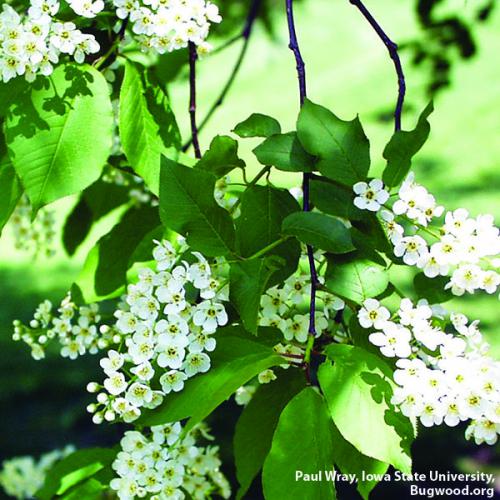
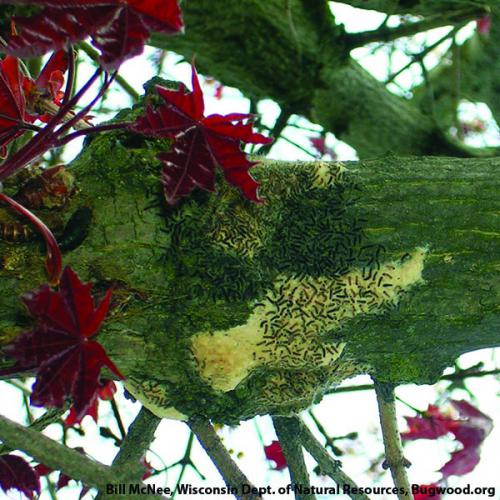
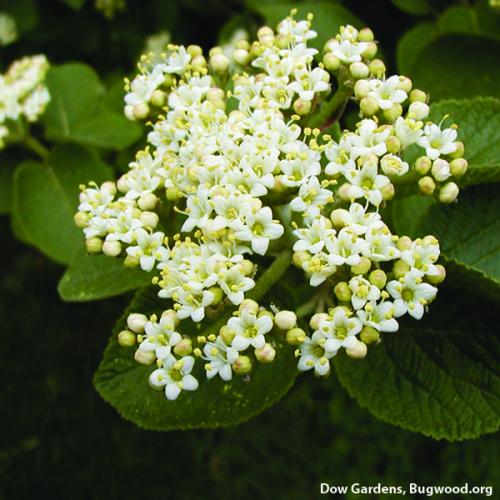
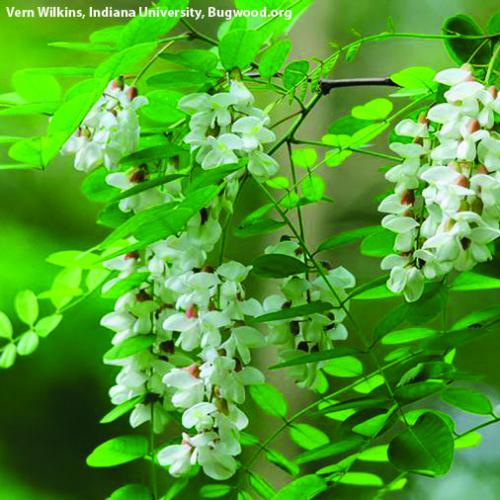
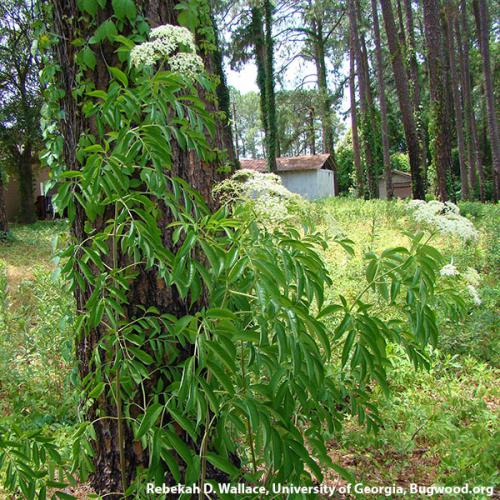

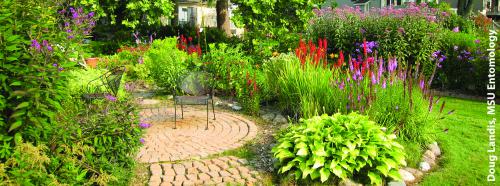
Read the next article in this publication series: Protecting pollinators during home lawn grub control
Or return to the beginning of this publication: How to protect and increase pollinators in your landscape



 Print
Print Email
Email





